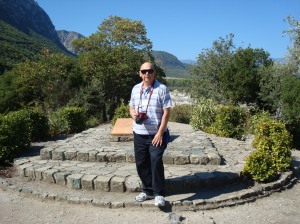We left Athens early in the morning for a six hour bus ride to the northern village of Kallabaka, but on the way we were making a stop to one of my “must see” spots- Thermopylae!
 Looking north from the burial mound the pass as it is today. From this direction the Persian came
Looking north from the burial mound the pass as it is today. From this direction the Persian cameThe name Thermopylae translated is “Hot Gates”. It refers to the hot sulfur springs in that area (hence thermo in the name). But, what Thermopylae is most known for is the battle that took place there in 480 BC and the 300 Spartans. This battle and that spot is as dear to me as my other passion- the Alamo.
Today Thermopylae looks very different from 480 BC, due to the fact that river silt has moved the sea coast by four to five miles. To best understand what happened there almost 2,500 years ago, picture Thermopylae in 480 BC as a pass between the shear mountain cliffs on the west side and the sea on the right being less that 300 feet wide. At the time, this passage was the only direct route into the Greek heartland from Asia Minor. The Persian King Xerxes, the son of Darius, who tried to conquer Greece and was defeated at the Battle of Marathon (where the name of the 26.2 mile race is taken from) in 490 BC, made it his goal to conquer Greece where his father failed. Xerxes amassed one of the largest armies of that day. Herodotus, the worlds first historian, wrote that the army had more than 1 million men. However, some believe that a few zeros could have been added during the translation. The most logical number would be closer to 100,000, still a massive number. The Greeks were not prepared for this size of an invasion and needed time. The theories for this lack of preparedness range from religious festivals to the Olympics going on that kept the Greeks from manning a defense. Whatever the reason, they weren’t ready. Leonidas, the King of Sparta was put in charge of the defense, taking his 300 personal Spartan guard along with those that he could muster from other City States he marched off the meet the Persians. The Greek army numbered around 7,000, against 100,000- good odds for the Greeks. Here comes Xerxes with his great army and there in front stands these pitiful few Greeks. Feeling compassionate Xerxes offers Leonidas and way out- lay down your arms and you can live. Leonidas sends back the famous answer- “Come and take them!’ One of the other famous sayings of that battle that I really like is that when told that the Persian archers’ arrows would be so thick that they’d block out the sun the Greeks responded by saying, “Good, then we can fight in the shade.” For two days Xerxes attacked and for two days the Greeks threw them back. The Persians loss thousands of men, the Greeks only a few. Then fate stepped in, a local Greek sold out his countrymen telling Xerxes that there was a goat path over the mountain and behind the Greek forces. Sending his best men over that path Xerxes planned on out flanking Leonidas’ men.
 Leonidas Statue and Memorial to the 300 Spartans
Leonidas Statue and Memorial to the 300 SpartansLeonidas heard of the attacking force and knowing that defeat and death was a sure thing sent his support Greeks back, planning on using his 300 Spartans and their helots, the 400 Thebans’ as the rearguard. Then another heroic thing happened that is often overlooked, or over shadowed by the legend of the 300 Spartans- General Demophilus and his 700 Thespians refused to leave, choosing to die with their fellow Greeks. From two sides the Persians attacked, with the Greeks fighting to the last man. These three days allowed the Greek City States to get organized and finally defeat Xerxes at the sea battle of Salamis. At Thermopylae today stands the monument to Leonidas and his 300 Spartans, which I heard is at the spot that the shore of the sea was then. Not far from this monument is the newer one finally honoring the Thespians that stood with the Spartans.
 The newer memorial to the Thespians near that of the Spartans
The newer memorial to the Thespians near that of the Spartans The Spartan burial mound across the road from the monuments
The Spartan burial mound across the road from the monumentsBut for me the most exciting thing was walking (I ran) across the road and climbing to the top of the mound where the Spartans and Thespians fought and are buried. On top of the mound is a memorial to those Spartans with the also famous inscription by Simonides- “Go tell the Spartans passerby, that here obedient to their laws we lie.”
 Standing on top of the burial mound by the memorial plaque
Standing on top of the burial mound by the memorial plaque “Go tell the Spartans passerbys, that here obedient to their laws we lie”, the words to honor the 300 Spartans by Simonides in Greek on this plaque at the top of the mound.
“Go tell the Spartans passerbys, that here obedient to their laws we lie”, the words to honor the 300 Spartans by Simonides in Greek on this plaque at the top of the mound.A few days later after we left Kallabaka we again came close to Thermopylae, turning off the main road and climbing over the mountain to Delphi. As I looked out the bus window at the battlefield below it hit me that we were following or at least crossing the goat path that the Persians took in 480 BC. Next: Parallels of History: Thermopylae and the Alamo
Wow you are like a history lesson. Obviously you were not there just for the weather and blue water
LikeLike